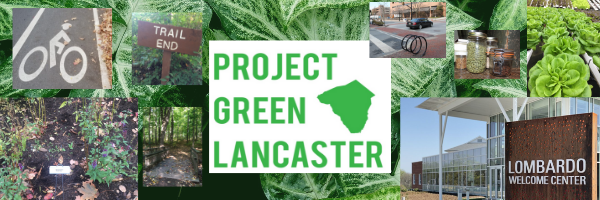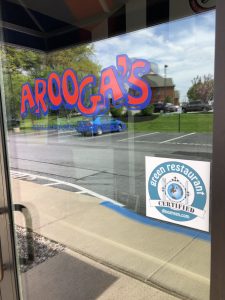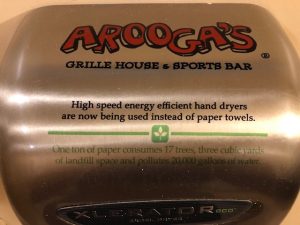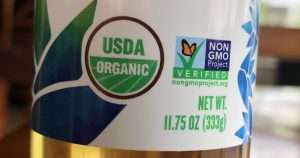The Green Restaurant Association reaches local Lancaster County restaurant to provide a more sustainable environment.
By: Laiklynne Reiter
From watching sports games to drinking beer and eating food, there’s not much else to ask for when it comes to spending a night out with friends. But what if you could do all of that while knowing you’re also being environmentally-friendly?
Arooga’s Grille House and Sports Bar is Lancaster County’s one and only Green Certified restaurant. In fact, Arooga’s was the first Green Certified restaurant in the state of Pennsylvania.
They opened their first set of doors back in 2008 and have slowly been expanding over the years. The Lancaster, Route 462 location, opened only a few short years ago in 2015. Since then, the restaurant chain has been booming.
With such a large menu, they certainly have something that anyone can enjoy. They offer over 80 different menu items that are under $8.99, so they try to be affordable for all budgets. From several different vegetarian and vegan dishes, along with many gluten free and organic items, they certainly give their customers plenty of options to choose from.
Being the only Green Certified restaurant in Lancaster County, they hold a higher standard among other nearby restaurants.
What is needed to be Green Certified?
All of their dining room tables are made from recycled wood and on top of every table you will find a roll of paper towels that they prefer to use over individual napkins. In order to be a Certified Green restaurant there are 7 different categories that need to be met and are measured using a point system.
The 7 categories include the following:
- Water efficiency
- Waste reduction & recycling
- Sustainable furnishings & building materials
- Sustainable food
- Energy
- Disposables
- Chemical & pollution reduction
Each one of those categories needs to be met and must reach a score of at least 80 points total in order to be considered a Level 1 Green Certified restaurant. The Route 462 location has been green certified since 2016 and has a score of 96.23, making them a Level 1, or 1-star restaurant in terms of green certification. Currently, all Arooga’s locations across the state are green certified.

Table created by Laiklynne Reiter ; Arooga’s Route 462 GRA Points ; Information found at http://www.dinegreen.com/find-restaurants
Each certified restaurant must fulfill the following:
- Accumulate a total of 100 points
- Meet minimum points in each of the 7 categories
- Have a recycling program
- Be free of polystyrene foam (styrofoam)
- Yearly education
The Green Restaurant Association’s (GRA) standards are designed to determine each restaurants environmental accomplishments and sustainability levels while also providing extra steps for them to improve their efforts towards becoming a 5-star green certified restaurant.
What makes Arooga’s green?
There are several ways that Arooga’s is a green restaurant. As mentioned previously, their tables are made from environmentally-friendly, reclaimed urban wood. They have an energy management system for the building, faucet aerators, they recycle cardboard, paper and grease, they do not have any styrofoam, they use recycled, tree-free, and biodegradable take-out containers and cutlery, and their dish machine detergent helps prevent pollution.
Along with being a green restaurant, they are also trying to reduce their carbon footprint and overall impact on the environment. Lights in parts of the building are set on timers, which is part of the energy management system. In each restroom, energy efficient hand-dryers are used, rather than paper towels. Also, non-toxic cleaning and chemical products are used and they recycle cardboard, plastic, paper, and oil. The restaurant hopes to continue adding new steps every year, becoming closer to a 5-star green restaurant.
With all of those things in mind, it is clear that Arooga’s is attempting to reduce their effect on the environment to help save our planet. They realize that every little bit helps and want to be a role model for other restaurants in the area to get them to take steps towards becoming a green restaurant. The future for Arooga’s becoming more environmentally-friendly is in the works and they hope to continue adding new steps every year.
Profiles:
Gary Huether, Jr.
As president and co-founder of Arooga’s Grille House and Sports Bar, Gary Huether, Jr. is living the dream. Born in Baltimore, Maryland and raised in central Pennsylvania, one could say he knows the local community very well. He grew up in Camp Hill, Pennsylvania and later attended Pennsylvania State University – Penn State Harrisburg.
At just 21 years old he owned a couple of Snap-On Tool franchises in both Maryland and Pennsylvania. It wasn’t until he turned 25 when the opportunity arose to purchase a local bar in Harrisburg, PA. Huether then sold his Snap-On Tool businesses and jumped on the offer.
Currently, Arooga’s has over 16 franchise locations ranging from Florida to Massachusetts, and around 10 corporate locations around central Pennsylvania.
Green Restaurant Association (GRA)
Established in 1990, the Green Restaurant Association (GRA) is an international nonprofit organization that is hoping to change the restaurant business to help out the environment.
The GRA encourages restaurant owners to green their operations to become environmentally sustainable. The GRAs certification system focuses on 7 different categories, the energy, water, waste, food, chemicals, disposables, and the building itself.
Each of the categories are then rated on a point-based scale which then determines the green level of the restaurant (1-5 stars). Each level requires a specific minimum amount of points that every restaurant must meet in order to be considered green certified.
Currently, the GRA is operating in 41 states as well as Canada and they hope to expand even further.
Related Articles:
Organic? What it Means and How it Helps the Environment.
We’ve seen the word more recently in the past couple of years, but what exactly is it? According to the official Organic website, “organic produce and other ingredients are grown without the use of pesticides, synthetic fertilizers, sewage sludge, genetically modified organisms, or ionizing radiation.” In other words, organic means that the farming methods used to make the foods were produced without using any pesticides, chemicals, or other artificial ingredients.
Recent studies have shown that organic foods have a higher nutritional value than most conventional foods, such as tomatoes. With this being said, not only are organic foods higher in nutrition, but they are also better for the environment.
Ways organic farming affects the environment:
- Eliminates soil and water contamination
- Preserves local wildlife
- Conserves biodiversity
- Reduces global warming
- Reduces erosion
Recycling: the Impact it Makes on Our Planet.
One of the best ways to help the environment is simple and easy to do: recycle. Recycling is a process where old materials are used to make new, reusable materials. There are many every day objects that can be recycled such as:
- Plastic bottles/containers
- Paper
- Cardboard
- Soda cans
- Glass
- Plastic bags
The list goes on and on, but the point is, there are many things that can be recycled and made into reusable material.
Recycling helps the planet and the environment in many different ways. The United States Environmental Protection Agency (EPA) said that some of those ways included conserving natural resources, preventing pollution, saving energy, increasing economic security, and reducing the amount of waste that gets sent to landfills around the world.
If there is one thing that the EPA would want the world to remember, it would be to reduce, reuse, and recycle.
References:
About us. Retrieved from http://www.dinegreen.com/about
Arooga’s grille house & sports bar. Retrieved from http://aroogas.com/
Certification standards. Retrieved from http://www.dinegreen.com/certification-standards
Environmental benefits of organic food production. Retrieved from https://www.eostreorganics.co.uk/environmental-benefits-of-organic-food-production.html
Find certified green restaurants. Retrieved from http://www.dinegreen.com/find-restaurants
Recycling basics. Retrieved from https://www.epa.gov/recycle/recycling-basics
2018. Arooga’s president Gary Huether, Jr. named to FSR magazine’s ’40 under 40 rising stars.’ Retrieved from https://www.restaurantnews.com/aroogas-president-gary-huether-jr-named-to-fsr-magazines-40-under-40-rising-stars/
2018. Frequently asked questions. Retrieved from https://organic.org/faqs/








